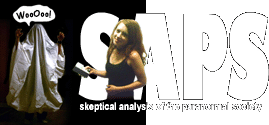Dowsing Rods and Clever Hans
How our expectations may give false results.
Dowsing rods are relatively common tools used in the search for paranormal activity amongst other things like missing children, medical diagnosing, underground water supplies, and mineral deposits. The accuracy of divining rods has increased their credibility over time, and most believers will instruct you to try it for yourself, and become a believer as well.
Many people do. Unfortunately, divining or dowsing rods are not scientific instruments as some people claim. Their basis lies more in human operation. Anything that relies entirely on a human for accuracy can be, for the most part, tossed aside in favor of more objective evidence.
Dowsing rods come in all shapes and sizes and are constructed out of a variety of materials. The ones featured on television shows are mostly of the type made from two narrow pieces of metal bent at right angles to allow the hand to grasp the rod. When these rods cross, it is because they have discovered water, an ailment, a ghost, your car keys, or a missing child. With all the things that dowsing rods are said to be capable of doing, it is a wonder that they do not remain perpetually crossed, having always "found" something.
The mechanics of dowsing rods are not questioned. They are simply objects, just like paper clips or pencils. However, while a paper clip can be proven to hold sheets of paper together, dowsing rods cannot be proven to find anything.
One of the things that takes away from credibility of dowsing rods is their reliance on human operators. This is similar to the planchette of a Ouija board, or the practice of "facilitated communication", where an individual with disabilities can write their thoughts as long as their arm (holding a pen or pencil) is held by a facilitated communication specially trained therapist.
Both of these phenomena are widely debated due to the necessity of human contact. A Ouija board planchette does not move on its own, and, in facilitated communication, a disabled patient does not write if their arm is held by a machine or stand rather than a human hand.
Believers in these phenomena have said that this may be because the planchette, the disabled person, and the dowsing rod all draw strength from the human contact, thereby allowing the mechanism to work.
One possible explanation that covers all these phenomena is called "Ideomotor Effect", an unconscious muscular reaction of the human body based on expectation. This has many similarities to The Placebo Effect, wherein medication, even if it is completely inert (like a sugar pill) will deliver the results expected of it. Our expectation trumps the apparently infallible machine, and only delivers results when a human with expectations is present.
An example of how we can communicate our desires can be discussed more easily if we use an example where human contact is removed, and yet expectation still yields results.
Enter "Clever Hans". Clever Hans was a horse adopted by a retired schoolmaster who was out to prove that animals had just as much intelligence as humans. He adopted Hans in 1900 and planned to teach him math, and show the world that animals could do all the things humans were capable of. Hans, for quite some time, fooled all the skeptics and researchers. Because, you see, when Hans was presented with a math problem on a chalkboard, he would stamp the number of the answer with his foot. It was amazing. Clever Hans became famous.
Scientists asked to borrow Clever Hans for further scrutiny. One of them had an idea - would Hans solve the problem on the chalkboard if he was the only one around? The answer was no. Hans could only solve the math problems if a human was present. This ties in with the planchette, the disabled person, and the dowsing rods, all only accurate if there is a human around.
In an effort to find out why, Hans was given problems on the chalkboard while a human was present - but the one present did not know the answer to the problem. This was another stumbling block for the mathematical powers of Clever Hans. He did not get the answer right if the person asking did not know the answer either.
Was Clever Hans psychic?
No. After much testing, it was decided that the people asking the questions of Hans (if they knew what the answer was) were giving cues. Hardly perceptible cues, like nodding their heads as Hans counted, and stopping when he had counted the correct number of times. This was not only done by the owner of Clever Hans, but by the scientists as well. They were completely unaware that they were cueing Hans.
The Ideomotor Effect refers to unconscious muscular responses to outside cues, ie: If you are in a location that is purported to be haunted, and outside cues like the temperature of the air or a creeping sensation on the back of your neck make you believe that something of a paranormal nature is occuring, you will unconsciously cross the dowsing rods as a reaction to this outside stimulus.
This does not mean that dowsers are intentionally fraudulent. It also does not mean that they are gullible or stupid. It may, in fact, just mean that they are very observant.
Unfortunately, expectation, in many cases, yields the expected results.
For further reading:
- http://www.randi.org/library/dowsing/
- http://www.diviningmind.com/
- http://skepdic.com/ideomotor.html
- http://www.kbrhorse.net/tra/hans.html
- http://www.cqc.state.ny.us/hottopics/fcnatal.htm
- http://www.betterhealth.vic.gov.au/bhcv2/bhcarticles.nsf/pages/Placebo_effect?OpenDocument
- http://www.kbrhorse.net/tra/hans.html
Back to the reports.
